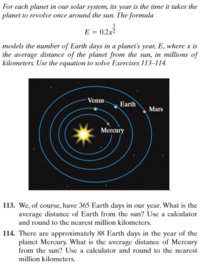TSschmigel
New member
- Joined
- Jan 26, 2023
- Messages
- 1
For each planet in a solar system, its year is the time it takes the planet to revolve around the center star. The formula
E = 0.2 x ^ 3 divided by 2
models the number of Earth days in a planet's year, E, where x is the average distance of the planet from the center star, in millions of kilometers. There are approximately
87.8
Earth days in the year of
Planet Upper A
.
What is the average distance of
Planet Upper A from the center star?
E = 0.2 x ^ 3 divided by 2
models the number of Earth days in a planet's year, E, where x is the average distance of the planet from the center star, in millions of kilometers. There are approximately
87.8
Earth days in the year of
Planet Upper A
.
What is the average distance of
Planet Upper A from the center star?




